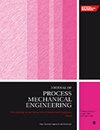On electrochemical machining with an interelectrode slit for a partially insulating cathode
IF 2.2
4区 工程技术
Q2 ENGINEERING, MECHANICAL
Proceedings of the Institution of Mechanical Engineers, Part E: Journal of Process Mechanical Engineering
Pub Date : 2024-08-02
DOI:10.1177/09544089241264186
引用次数: 0
Abstract
Electrochemical machining is an established non-conventional machining process in which material removal during electrolysis relies on the quantity of electricity passed through the electrolyte. The amount of electricity passed further depends on several factors, such as electrochemical reactivity/dissolution, penetration rate, tool properties (profile, surface area, and material), electrical conductivity, chemical composition, temperature sensitivity, crystal structure, and initial surface roughness (Ra) of workpiece material, voltage, feed rate, electrolyte selection/concentration, etc. As per reported studies, a thermoplastic inter-electrode slit of rectangular/square profile between the tool and workpiece in modified electrochemical machining helps to generate the cavity with a better aspect (h/d) ratio without changing the tool profile. However, little has been reported on the effect of variation in interelectrode slit thickness on material removal rate/penetration rate. In this study, the results of experimental investigations for material removal rate/penetration rate with modified electrochemical machining using a square inter-electrode slit of variable thickness between the cathode (circular tool) and anode (workpiece) with 03 different materials (Al, Cu, and Ti) have been presented. Taguchi L关于部分绝缘阴极带电极间狭缝的电化学加工技术
电化学加工是一种成熟的非常规加工工艺,电解过程中材料的去除取决于通过电解液的电量。通过的电量取决于多个因素,如电化学反应/溶解、穿透率、工具特性(轮廓、表面积和材料)、导电性、化学成分、温度敏感性、晶体结构和工件材料的初始表面粗糙度 (Ra)、电压、进给速度、电解液选择/浓度等。根据已报道的研究,在改良电化学加工中,刀具和工件之间的矩形/方形热塑性电极间缝有助于在不改变刀具轮廓的情况下产生具有更好纵横比(h/d)的空腔。然而,有关电极间狭缝厚度变化对材料去除率/穿透率影响的报道却很少。在本研究中,介绍了使用阴极(圆形工具)和阳极(工件)之间厚度可变的方形电极间缝隙,对 03 种不同材料(Al、Cu 和 Ti)进行改良电化学加工的材料去除率/穿透率的实验研究结果。改良电化学加工工艺的参数优化采用了基于正交阵列的 Taguchi L18 实验设计。总体而言,改良电化学加工中材料去除率的最佳设置为电解液浓度 150 g/L、电压 21 V、刀具材料 Cu、工件 Al、电极间缝隙厚度 1.5 mm 和刀具进给速度 132 µm/min。研究结果通过扫描电子显微镜、能量色散光谱和 Ra 分析进行了验证。
本文章由计算机程序翻译,如有差异,请以英文原文为准。
求助全文
约1分钟内获得全文
求助全文
来源期刊
CiteScore
3.80
自引率
16.70%
发文量
370
审稿时长
6 months
期刊介绍:
The Journal of Process Mechanical Engineering publishes high-quality, peer-reviewed papers covering a broad area of mechanical engineering activities associated with the design and operation of process equipment.

 求助内容:
求助内容: 应助结果提醒方式:
应助结果提醒方式:


